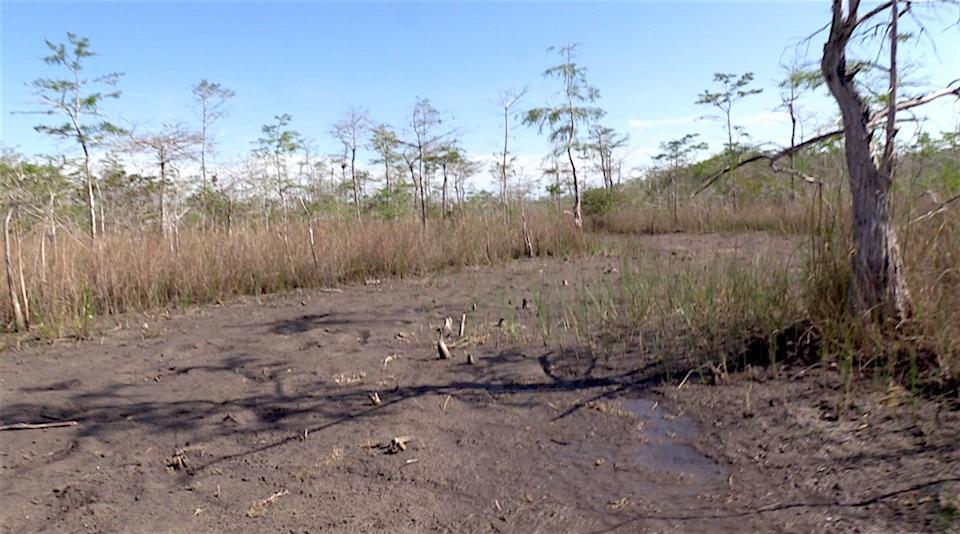
The U.S. Army Corps of Engineers has reversed its ruling that Burnett Oil Company would need a Clean Water Act permit to resume exploration in Big Cypress National Preserve/Kurt Repanshek file
In somewhat of a surprising reversal, the U.S. Army Corps of Engineers has told an oil exploration company that it can resume seismic operations in Big Cypress National Preserve in Florida without the Corps' oversight.
It was back on March 6 when Robert Halbert, the Corps' chief of compliance and enforcement in the Jacksonville, Florida, district, wrote Burnett Oil Co. President Charles Nagel to say the exploration work was in fact “mechanized land clearing, ditching and channelization,” activities that “caused an impact that resulted in a change in the bottom elevation of the wetland, that the activity caused an identifiable individual and cumulative adverse effect on aquatic function, and that the survey had the adverse effect of degrading a water of the U.S.”
Furthermore, Halbert told Nagel that the company would have to coordinate any future survey work “with the Corps in accordance with the Clean Water Act. A permit will be required of you unless and until you can demonstrate to the satisfaction of the Corps or Environmental Protection Agency, prior to commencing the activity involving the discharge, that the activity would not have the effect of destroying or degrading any area of waters of the United States.”
But this past Tuesday that directive was lifted by Col. Andrew D. Kelly, Jr., the district's commander who reached his decision after talking with Big Cypress staff.
"Jacksonville District rescinds the conclusions specified in the previous letter and asserts no further action is being taken by Jacksonville District or required of Burnett for its completed seismic survey," the colonel wrote in a letter to Nagel. "Given the environmental sensitivity in the Big Cypress National Preserve and your expressed commitment to environmental stewardship, Jacksonville District looks forward to working with you on any future actions to clearly and transparently identify and take the appropriate action on any regulatory requirements and communicate in a professional manner as we aspire to do with every potential applicant."
When I visited the preserve in early March, the very same day Halbert sent his letter to Nagel, I found scars 20 or more feet wide in places, and said to be running roughly 100 miles across the preserve. They were the footprints of oil exploration conducted by Burnett in 2017 and 2018. Some sections of these “seismic lines” are regaining their vegetative cover, others bear rutted troughs unnaturally holding water; certain sites are practically devoid of vegetation (above photo) despite the preserve’s subtropical climate and highly diverse botanical collection.
The seismic lines were created by Burnett’s use of ponderous “vibroseis” trucks that can weigh 30 tons to search for oil reserves. The vehicles, which some call “thumper trucks,” create ground-penetrating seismic waves by exerting all their weight onto a vibrating steel pad. Small instruments called “geophones” in turn receive the shock waves, and geologists use the waves to create three-dimensional maps of the underlying ground.
It's not known what those first two years of exploration detected, though the company did not return to Big Cypress this past winter to resume exploration.
"There isn’t any supporting science that we’re aware of," Alison Kelly, an attorney with the Natural Resources Defense Council, said of Col. Kelly's decision. "The reversal appears to have been based solely on conversations between the Corps and preserve staff."
It was past work hours when Traveler learned of the colonel's letter Friday evening, and too late to reach out for comment.



Comments
Rick, you need to expand your "world" view. There is hardly unanimity on how to address the virus. Heck Fauci can't even tell the same story week to week. Carefully constructed fables? What was Aesopian about my comment. Other than my opinion at the end, which is clearly expressed as such, everything is pure facts.
My apologies - I intended to state "worldwide unanimituy of opinion that this is a health crisis". If you have documentation that the statistics are padded, you should state your case with documentation. And then shut up, as I'm about to. I've read the comments about the mudwrestling here in Kurt's comments area and am tlrying to minimize how much I contribute to it by shutting up. How about you?
Rick, Have you not seen the story reported by the NYTs that NYC added 3,700 cases well after the fact to their list of COVID deaths even though they had not been tested for COVID? Have you not seen the reports of code merging? Have you not heard the doctors that have come out to say they are being pressured to code deaths as COVID deaths even if they don't know if that is the cause?
https://www.nytimes.com/2020/04/14/nyregion/new-york-coronavirus-deaths....
https://www.youtube.com/watch?v=NjjybyJ59Lw&feature=share
http://www.informationliberation.com/?id=61367
https://knst.iheart.com/featured/garret-lewis/content/2020-04-09-doctor-...
Even with that padding, the numbers for COVID are a small fraction of other common diseases and ailments. For that we are selling out both our physical and economic future. The best way to get through this is not self isolation with the resulting depression, excessive alcohol, bad diet, lack of excercise and neglect of routine prophilactic measures (physicals, mamograms, colonoscopies ......). The answer, if you are healthy, which the overwhelming majority of us are, up your vitiman A, C & D and get outside for sunshine and fresh air. No better place to do than than a national Park.
From the CDC website:
What is a COVID-19 case?
CDC U.S. COVID-19 case counts and death counts include both confirmed and probable cases and deaths. This change was made to reflect an interim COVID-19 position statement pdf icon[10 Pages, 251 KB]external icon issued by the Council for State and Territorial Epidemiologists on April 5, 2020. The position statement included a case definition and made COVID-19 a nationally notifiable disease
Includes "probable" cases. Attribute the death to COVID without any evidence the deceased actually had COVID much less died from it. Naw, there's no padding.